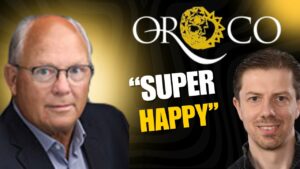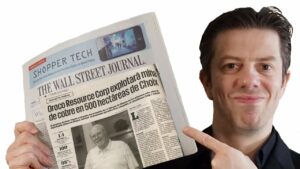Results reported in this news release pertain to test work conducted by Kappes, Cassidy and Associates, Reno (“KCA”) on the silver mineralization from the three areas of the silver deposit: “Shallow Silver Zone, “Centenario Zone”, and “Fonteriza Zone”, and on SART test work (a metallurgical process that regenerates and recycles the cyanide used in the leaching process of the silver) performed by BioteQ Environmental Technologies Inc. (“BioteQ”). This news release does not include work on the “High grade” zinc zone which is still ongoing and sits underneath and adjacent to the silver mineralization.
HIGHLIGHTS INCLUDE:
- An overall average silver recovery of 73.2% with peak values ~89.0%
- Recovery of between 40% – 50% of the “low grade” zinc mineralization at the SART stage, previously thought unrecoverable. (low grade zinc resource is estimated at 1.53 billion pounds of indicated zinc metal)
- A mining and metallurgical flow sheet that will recover silver, zinc, and potentially lead
- Greater than 98% recycling of cyanide via the SART process — Cyanide is one of the most expensive reagents used in the leaching process, so the recycling of this will have a significant positive effect in lowering the overall costs.
- Room to optimize and improve recoveries to 75%-80%
Test work on leaching the silver ore at Sierra Mojada has been conducted by KCA. Work has focused on cyanide leach recovery of the silver, and zinc and copper, using “Bottle Roll” tests to simulate an agitation leach system common on many mine sites.
Samples have been taken separately from drill core, mineralized outcrop, and trenches from the “Centenario”, “Fonteriza” and “Shallow Silver” Zones of the deposit and have been crushed and mixed to create either a “composite” sample representative of each of the 3 zones, or a series of composite samples based on the silver grade for each of the three zones.

SUMMARY OF SILVER RESULTS
A summary of results for the cyanide leach test work on silver recovery is shown in the table below.
KCA | Sample Description | Target p80 Size, mm | Leach Solution NaCN Conc., | Calculated Head, | % Ag Recovery |
|---|---|---|---|---|---|
64605 | Centenario, Composite No. 5 (10 to 20 gms Ag/MT) | 0.074 | 5.0 | 16.9 | 76.7% |
64601 | Centenario, Composite No. 1 (10 to 20 gms Ag/MT) | 0.074 | 5.0 | 17.5 | 68.5% |
64602 | Centenario, Composite No. 2 (20 to 30 gms Ag/MT) | 0.074 | 5.0 | 23.3 | 69.6% |
64606 | Centenario, Composite No. 6 (20 to 30 gms Ag/MT) | 0.074 | 5.0 | 24.6 | 76.2% |
65609 | Centenario, Composite No. 9; (30 to 60 gms Ag/MT) | 0.074 | 5.0 | 41.6 | 81.8% |
65441 | Centenario, Composite No. 7; (30 to 60 gms Ag/MT) | 0.053 | 1.0 | 42.6 | 85.0% |
64603 | Centenario, Composite No. 3; (30 to 60 gms Ag/MT) | 0.074 | 5.0 | 43.3 | 81.8% |
65610 | Centenario, Composite N0. 10: (~100 gms/MT) | 0.074 | 5.0 | 104.0 | 79.0% |
64604 | Centenario, Composite No. 4; (>60 gms Ag/MT) | 0.074 | 5.0 | 105.8 | 88.4% |
65608 | Centenario, Composite No. 8; (> 60 gms Ag/MT) | 0.074 | 5.0 | 172.4 | 89.0% |
65743 | Fronteriza, Composite No. 1; (35 to 50 gms Ag/MT) | 0.044 | 10.0 | 43.6 | 51.0% |
65744 | Fronteriza, Composite No. 2; 50 to 100 gms Ag/MT | 0.045 | 5.0 | 67.4 | 55.0% |
65745 | Fronteriza, Composite No. 3 (100 to 150 gms Ag/MT) | 0.040 | 5.0 | 126.2 | 60.0% |
65746 | Fronteriza, Composite No. 4 (150 to 200 gms Ag/MT) | 0.038 | 10.0 | 182.9 | 62.0% |
65747 | Fronteriza, Composite No. 5 (200+ gms Ag/MT) | 0.053 | 20.0 | 597.0 | 86.1% |
63604 | Shallow Silver Zone, Core Composite | 0.053 | 20.0 | 57.6 | 70.7% |
65770 | Shallow Silver, Composite No. 2 (45 to 100 gms Ag/MT) | 0.053 | 20.0 | 65.8 | 68.2% |
65771 | Shallow Silver, Composite No. 3 (100 to 150 gms Ag/MT) | 0.053 | 20.0 | 110.1 | 68.7% |
AVERAGE | 73.2% | ||||
Observations from these results include;
- Silver recoveries generally show an increase with higher grade.
- Silver recovery is grind size sensitive with finer grinds giving higher recoveries.
- Due to high cyanide soluable zinc values, cyanide concentration is critical to maximize silver recovery.
SUMMARY OF THE ZINC RESULTS
In addition to the tests assessing the silver recoveries via cyanidation, KCA performed cyanide leach tests to determine the recovery of the “low grade” zinc to the leach solution. The following two tables provide the results of the zinc recoveries to cyanide solution in the cyanide leach tests.
Sample Description | Target NaCN, gpL | Average Head, | Avg. Tails, | Zn Extracted, |
|---|---|---|---|---|
Shallow Silver Zone | 10 | 7,750 | 4,380 | 41% |
Centenario | 10 | 2,080 | 1,540 | 26% |
Fonteriza | 10 | 18,870 | 7,359 | 64% |
Average All Tests |
|
|
|
It should be noted that the zinc recovery was still climbing at the end of the majority of the leach tests, indicating that higher zinc recoveries are possible if higher cyanide concentrations are used. Silver recoveries are also expected to increase with higher cyanide concentrations.
THE SART PROCESS:
The purpose of the “SART” process (Sulfidization, Acidification, Recycling and Thickening) is to;
- Regenerate and recycle the cyanide used in the leaching process of the silver, and zinc — thereby significantly lowering cyanide costs — one of the major costs in any leach process.
- Recover the zinc as saleable sulphide concentrates. Selling this concentrate will contribute significantly to reducing the net operating costs of the SART circuit.
The following were concluded after analyzing the experimental data for various reaction conditions:
- Recovery of WAD cyanide to free cyanide was close to 100% under operating conditions.
- Zinc can be recovered from the barren leach solution (BLS) using both sulphide sources (NaHS and H2S).
- Zinc grade of the concentrate is predicted to be between 63%-64%, considered a high-grade zinc sulphide product.
- The small amount of silver that was present in the BLS was removed from solution to below detection limit of the analytical equipment and reported to the metal sulphide solids.
A summary of the mining flow sheet for the silver mineralization at Sierra Mojada is shown below. The metallurgical results reported in this news release refer to the “VAT leach” — “Merrill Crowe” — “SART” steps of the diagram below. The products produced at the various steps are shown on the right hand side of the diagram.

Figure 1. Mining flow sheet for silver mineralization at Sierra Mojada
TESTWORK ON THE LEAD
Floatation testwork on the lead mineralization is currently underway. With over 537 million pounds of contained lead metal, the lead has the potential to provide significant upside to the project. The ore containing the lead mineralization will already have been milled and will only need to be passed through a floatation cell either prior to vat leaching or after vat leaching on the way to the tailings dam.
Tim Barry, President, CEO and director of Silver Bull states, “We are extremely pleased with the results of the metallurgical program. Work going forward on the metallurgy will now focus on optimizing and improving the silver and low grade zinc recoveries at various steps along the process, and examining the potential to extract more value from lead and zinc. By unlocking the metallurgy we have taken another major step forward in development of one of the largest undeveloped silver resources in Mexico. The next step for the company is a Preliminary Economic Assessment which we expect to have out to the market in the third quarter of this year.”
THE NEXT STEPS GOING FORWARD
- Cyanide leach tests will continue on the silver, low-grade zinc and copper ore to optimize recovery and leach time. Drivers to improve recovery will include stronger cyanide solutions, grind size of the ore, and leaching residence times.
- Floatation tests on the lead mineralization
- Floatation tests are also underway on the “high grade” zinc (>8%) mineralization which sits underneath the silver mineralization at the eastern end of the deposit.
The technical information of this news release has been reviewed and approved by William J. Pennstrom, Jr., a qualified person for the purposes of National Instrument 43-101. Mr. Pennstrom, a consulting process engineer and President of Pennstrom Consulting, Inc. has acted as the Qualified Person, as defined by NI 43-101, for evaluation of the metallurgical testing data. He has over 30 years of experience in mineral process design and operation, and has been an independent process and metallurgical consultant for the mining industry for the last 12 years. He is a Registered Member of the Society of Mining, Metallurgy and Exploration (SME Member No. 2503900). Mr. Pennstrom and Pennstrom Consulting Inc. are both independent of the Company under NI 43-101.
On behalf of the Board of Directors
“Tim Barry”
Tim Barry, MAusIMM
Chief Executive Officer, President and Director
INVESTOR RELATIONS:
Matt Hallaran
+1 604 336 8096
info@silverbullresources.com
Cautionary Note to U.S. Investors concerning estimates of Indicated and Inferred Resources: This press release uses the terms “indicated resources” and “inferred resources” which are defined in, and required to be disclosed by, NI 43-101. We advise U.S. investors that these terms are not recognized by the United States Securities and Exchange Commission (the “SEC”). The estimation of indicated resources involves greater uncertainty as to their existence and economic feasibility than the estimation of proven and probable reserves. U.S. investors are cautioned not to assume that indicated mineral resources will be converted into reserves. The estimation of inferred resources involves far greater uncertainty as to their existence and economic viability than the estimation of other categories of resources. U.S. investors are cautioned not to assume that estimates of inferred mineral resources exist, are economically minable, or will be upgraded into measured or indicated mineral resources. Under Canadian securities laws, estimates of inferred mineral resources may not form the basis of feasibility or other economic studies.
Disclosure of “contained ounces” in a resource is permitted disclosure under Canadian regulations, however the SEC normally only permits issuers to report mineralization that does not constitute “reserves” by SEC standards as in place tonnage and grade without reference to unit measures. Accordingly, the information contained in this press release may not be comparable to similar information made public by U.S. companies that are not subject NI 43-101.
Cautionary note regarding forward looking statements: This news release contains forward-looking statements regarding future events and Silver Bull’s future results that are subject to the safe harbors created under the U.S. Private Securities Litigation Reform Act of 1995, the Securities Act of 1933, as amended (the “Securities Act”), and the Securities Exchange Act of 1934, as amended (the “Exchange Act”), and applicable Canadian securities laws. Forward-looking statements include, among others, statements regarding forecasted of indicated and inferred resources, metallurgical optimization results, ability to use the SART process to recycle cyanide and recover zinc and copper, and the timing of the preparation and completion of a Preliminary Economic Analysis. These statements are based on current expectations, estimates, forecasts, and projections about Silver Bull’s exploration projects, the industry in which Silver Bull operates and the beliefs and assumptions of Silver Bull’s management. Words such as “expects,” “anticipates,” “targets,” “goals,” “projects,” “intends,” “plans,” “believes,” “seeks,” “estimates,” “continues,” “may,” variations of such words, and similar expressions and references to future periods, are intended to identify such forward-looking statements. Forward-looking statements are subject to a number of assumptions, risks and uncertainties, many of which are beyond our control, including such factors as the results of exploration activities and whether the results continue to support continued exploration activities, unexpected variations in ore grade, types and metallurgy, volatility and level of commodity prices, the availability of sufficient future financing, and other matters discussed under the caption “Risk Factors” in our Annual Report on Form 10-K for the fiscal year ended October 31, 2012, as amended, and our other periodic and current reports filed with the SEC and available on www.sec.gov and with the Canadian securities commissions available on www.sedar.com. Readers are cautioned that forward-looking statements are not guarantees of future performance and that actual results or developments may differ materially from those expressed or implied in the forward-looking statements. Any forward-looking statement made by us in this release is based only on information currently available to us and speaks only as of the date on which it is made. We undertake no obligation to publicly update any forward-looking statement, whether written or oral, that may be made from time to time, whether as a result of new information, future developments or otherwise.

















